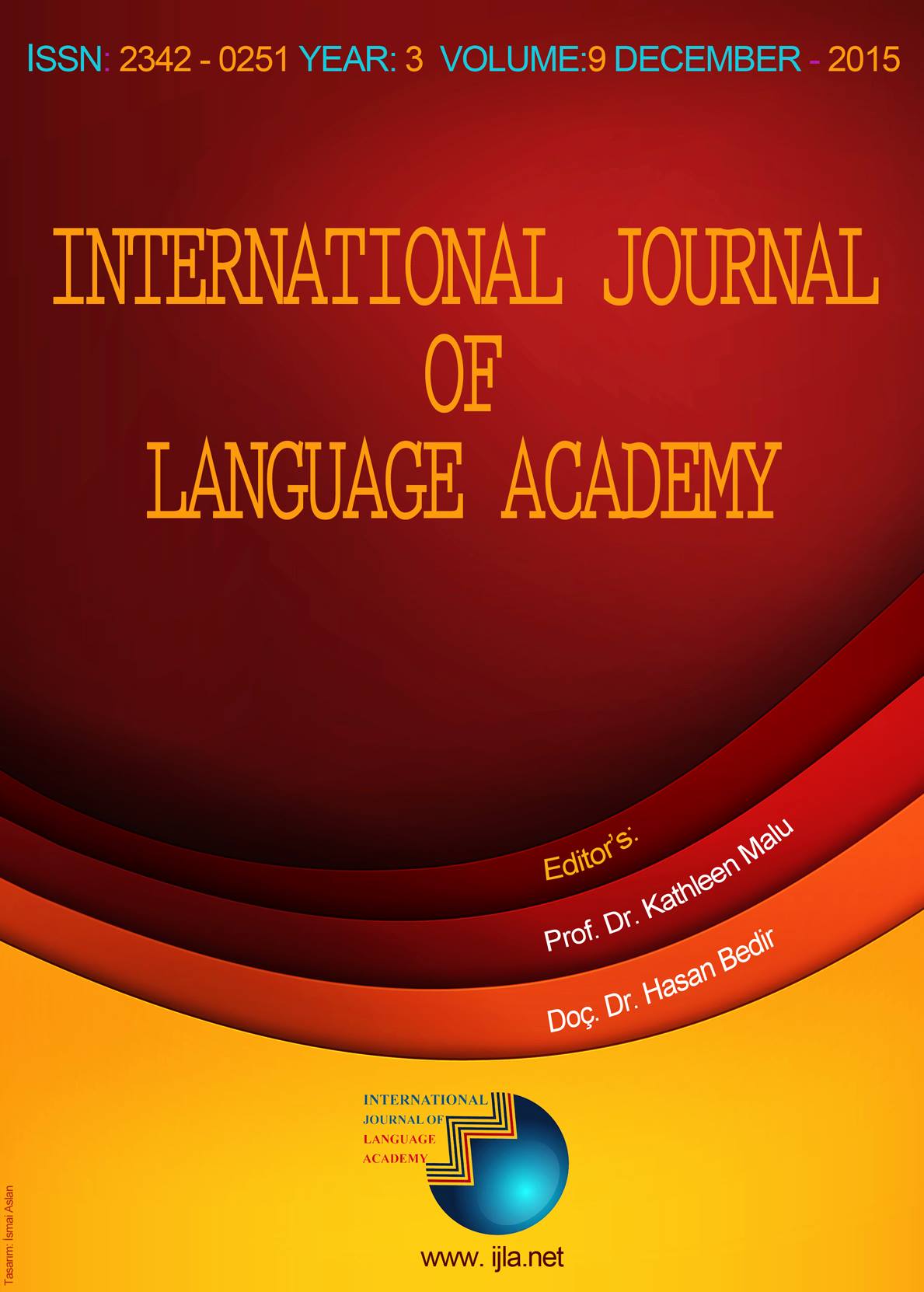İNGİLİZCE ÖĞRETMENLERİ VE ÖĞRENCİLERİ ARASINDA LATİNCE VE YUNANCA KÖKLER ARACILIĞIYLA KELİME ÖĞRENİMİ VEYA ÖĞRETİMİNİN FARKINDALIĞINI ARTTIRMA
Author :
Abstract
Arka plan: Öğrencilerin önünde başa çıkmaları gereken binlerce kelime olduğu için kelime bilgisi dil öğrenmenin en göz korkutan yönüdür. Ancak, çocukların kelime öğrenmek gibi bir korkusu yoktur ve ana dillerini, üzerinde hiç kafa yormadan öğrenebilirler. Çocukların daha farkında olmadan öğrenebilmelerindeki sır, çok sayıda başarılı kelime öğrenimi ve hafızada saklanması açısından ipucudur. Amaç: Bu makalenin amacı, Latince ve Yunanca kökler aracılığıyla çok sayıda kelime öğretiminin/öğreniminin ve hafızaya yerleşiminin etkililiği hakkında farkındalığı artırmaktır. Yöntem: Öğrencilerin kendi öğrenme süreçlerinin farkında olup olmadıklarını görmek amacıyla içinde açık uçlu iki adet soru (Hangi kelime öğrenme stratejilerini kullanırsınız? Kelime öğrenme stratejilerinden hangisini tercih edersiniz/Neden?) bulunan yazılı bir ön ve bir son görüşme yapıldı. Ayrıca Öğrencilerin Kelime Öğrenme Stratejileri (KÖS) anketi, öğrencilerin KÖS tercihlerini ve Latince/Yunanca kelime kökleri aracılığıyla eğitim ve öğrenmeye karşı yaklaşımlarını görmek için uygulandı. Son olarak, yeni kelimelerin öğretimini, öğrenimini ve kalıcılığını desteklemek için Latince/Yunanca köklerin derslere dâhil edilişini ve derslerde kullanımını teşvik etmek ve kullanmak amacıyla bu makalenin yazarı tarafından mini bir müfredat geliştirilip uygulandı.Sonuç: Adana Bilim ve Teknoloji Üniversitesi Yabancı Diller Yüksekokulu hazırlık öğrencileri hep ihmal edilmiş bir strateji olan kökler aracılığıyla kelime öğrenimine karşı olumlu bir tavır geliştirmişlerdir. Bu çalışmanın sonuçları, bu alanda yapılan diğer benzer çalışmalara paraleldir. Bu nedenle, kök ve eklerle İngilizce kelimelerin anlamını tahmin etme, onların akılda kalıcılığını sağlama ve kontrolü için güç kazanma fırsatı kaçırılmamalıdır.
Keywords
Abstract
Background: Vocabulary knowledge is the most daunting part of language learning as there are thousands of words to cope with before a learner. However, children do not have any fear of learning words and they learn their mother tongue without even thinking about it. The secret of children, in learning a language without even noticing, is a clue for huge amount of vocabulary learned or retained successfully. Aim: The aim of this article is to raise awareness about the effectiveness of teaching or learning and retaining large number of vocabulary through Latin and Greek roots. Method: A pre- and post-written interview with two open ended questions (What vocabulary learning strategies do you use? What vocabulary learning strategy do you prefer to use/Why?) were implemented to see whether the students were aware of their own vocabulary learning process. A ‘Vocabulary Learning Strategies’ (VLSs) questionnaire was used in the study to see students’ VLS preferences and their attitude to Latin/Greek word roots instruction or learning. Finally, a mini-syllabus was developed and utilized by the author of this article throughout the study whose aim is to use and promote the inclusion of Latin/Greek roots instruction in classrooms to help teach, learn, retain and recall new words.Results and Conclusions: English preparatory year students at School of Foreign Languages in Adana Science and Technology University have developed a positive attitude towards learning words with roots, which is a strategy that has been neglected. The results of this study are parallel to previous studies alike in the field. Therefore, the opportunity to guess, retain and gain the power to control the meaning of English words with the use of roots and affixes should be grasped.
Keywords
- Akarslan, K. (2013). Akarslan’s affixionary: Kelimeleri böl ve yönet. Akademisyen Kitabevi.
- Bellomo, T. S. (2005). Latinate word parts and vocabulary: Contrasts among three groups comprising the community college preparatory reading class. Doctoral dissertation: the College of Education, the University of Central Florida, Orlando, FL. Retrieved December 20, 2014, from http://www.sciencedirect.com
- Bellomo, T. S. (2009). Morphological analysis and vocabulary development: Critical criteria. The Reading Matrix, 1, (Vol. 9, pp. 44-55). Retrieved December 20, 2014, from http://www.readingmatrix.com/articles/bellomo/article.pdf
- Blachowicz C., & Cobb C.(2007). Teaching vocabulary across the content areas: ASCD Action Tool.
- Booth, F. M. (1980). A high school administrator's defense of Latin. The Classical Outlook, 57(4), 84-85.
- Fiske, B. E., Mallison, J., & Mandell, M. (2006), Sourcebooks, Inc.
- Karlıova H. (2009). Teaching English vocabulary through latinate word parts to undergraduate students learning English as a foreign language. Marmara University, MA Thesis.
- Lafleur, R. A. (1985). 1984: Latin in the United States twenty years after the fall. Foreign Language Annals, 18(4), 341-346.
- Lewis, N. (1979). Word power made easy. Pocket Books.
- Masciantonio, R. (1985). Say it in Latin. Principal, 64(4), 12-14.
- Yazdi, M., & Kafipour, R. (2014). A qualitative study of vocabulary learning strategies applied by Iranian undergraduate EFL learners in real learning setting. English Language Teaching (Jul 2014): 1-7.
